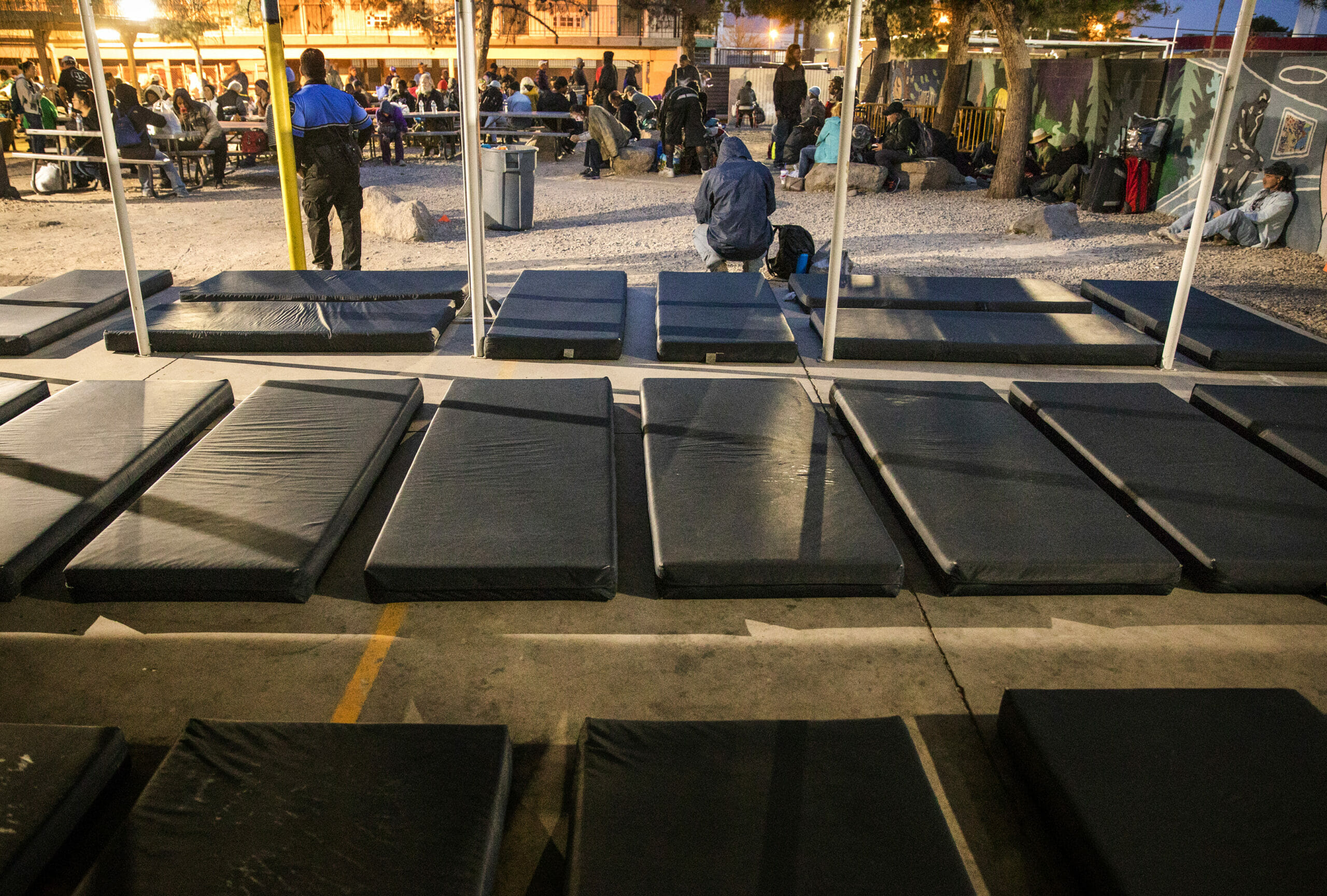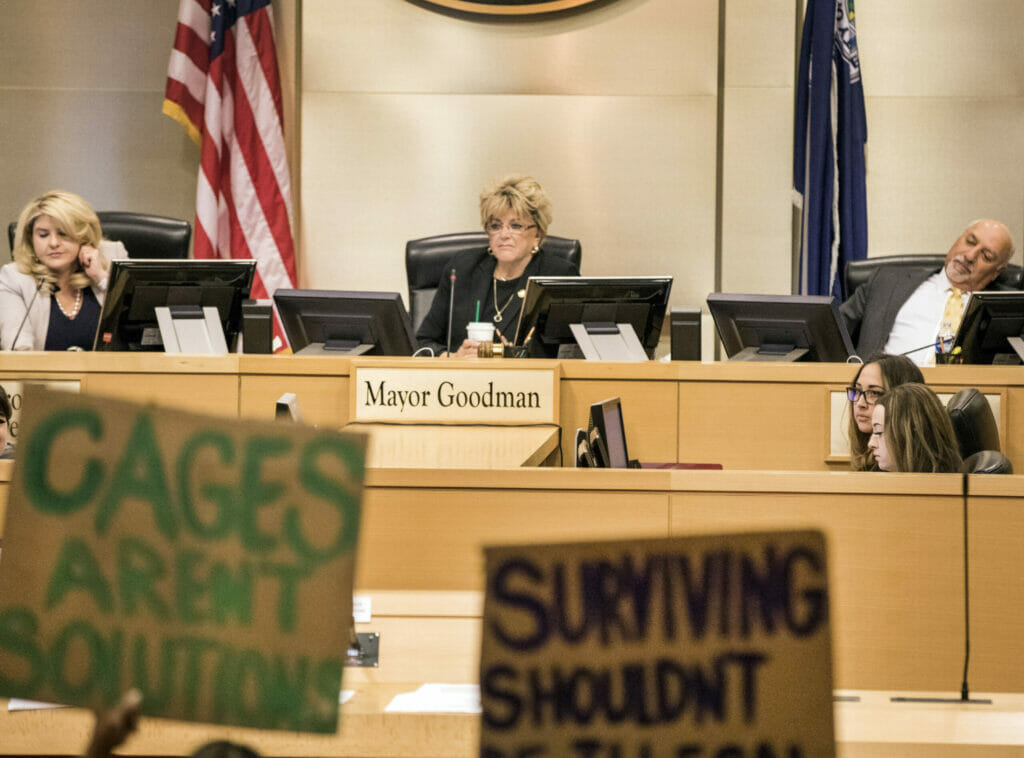Heading into 2020, where does Southern Nevada stand on responding to homelessness?

This holiday season, more than 200 families in Southern Nevada are in line for something most people take for granted: a roof over their heads.
“Right now we have more people sitting in that queue for longer than we want, and that just comes down to affordable units that we can get folks into,” Clark County Administrator of Human Services Tim Burch said in an interview with The Nevada Independent. “It’s just finding landlords who understand. When rent’s skyrocketing here, it’s getting increasingly hard for individuals to find housing.”
Burch’s comment came after a presentation about the Southern Nevada Continuum of Care’s efforts to address homelessness. Burch gave the presentation to Clark County commissioners on Dec. 3, a report of a volatile year for homelessness service providers and partners working to combat the region’s issues and the related lack of affordable housing.
At the end of 2019, more than 1,000 single adults without children and more than 100 unaccompanied youth are on a waiting list to be matched with regional housing programs.
Nevada ranks the second lowest in the nation for affordable housing, with 14 extremely low-income (ELI) units available per every 100 that are needed. ELI was defined as “households with income at or below the Poverty Guideline or 30 percent of area median income, whichever is higher.”
The combined shortage of ELI and very-low income (VLI) units was more than 130,000 units, according to an earlier presentation given by Clark County’s Assistant Manager Kevin Schiller. VLI was defined as households with income between 30 and 50 percent of the area median income (AMI) in the metropolitan area.
Regional partners who work toward ending homelessness and the lack of affordable housing understand that these issues do not exist in a vacuum; they are influenced by a number of factors including the economy, policy and vulnerable populations’ access to prevention and intervention services.
Implementing sitting and camping ordinances
The City of Las Vegas is gearing up to implement an ordinance that will go into effect on Feb. 1, making sitting and camping in public rights-of-way a misdemeanor offense.
In the last City Council meeting of the year, Mayor Carolyn Goodman was not present and had requested that a vote on a second camping ordinance — which would put further restrictions on sitting and lying down in public places in the city — be delayed until Jan. 15. The reason she provided for delaying the vote was that a scheduling conflict prevented her from being present to discuss the item.

In response to the delayed vote, there was speculation that city officials were reconsidering the ordinance because a recent Supreme Court decision to let stand the 9th Circuit Court’s decision in City of Boise v. Martin, which said that jailing or ticketing a person for sitting or sleeping outside was unconstitutional if the individual has nowhere else to go. The court decision was brought to the City Council’s attention several times on the day that the first camping ordinance was approved on Nov. 6.
City officials have maintained that the court’s decision has nothing to do with delaying the vote on the second ordinance, and that they are confident that their ordinances will stand up if a lawsuit like Boise v. Martin is filed against the city. To prevent such a lawsuit, critics have said that communications between the city, shelters and law enforcement will need to ensure that each entity knows when there is availability at approved shelters.
In an interview with The Nevada Independent last month, Office of Community Services Director Kathi Thomas-Gibson said that the city was still working on making that information available on a “systems level.”
Regional partners use the Homeless Management Information System (HMIS) to keep track of case management for homeless clients, but the system does not provide real-time updates on when shelters have openings or are at capacity.
Las Vegas Metro Police Lt. Timothy Hatchett and other members of law enforcement have raised concerns about how police officers and city marshals will be expected to enforce sitting and camping ordinances.
“One component that needs to be discussed and has been briefly discussed in some venues is a court side to this, where if someone is subject to this enforcement, there is a homeless type [of] court that can plug them into services that are so desperately needed,” Hatchett said during public comment at the Nov. 6 meeting.
“Our biggest concerns are that the officers have the resources so they don’t have to make an arrest. We don’t have the time or the ability to transport someone on a misdemeanor crime, as fulfilling this ordinance [might require],” Scott Nicholas, vice president of the Las Vegas Police Protective Association, said in an interview.
Nicholas added that it was still unclear what procedures would be put in place for moving large amounts of personal property and transporting the offenders to the shelters.
Affordable housing initiatives
On Dec. 17, the Clark County commissioners approved a list to be submitted to the Bureau of Land Management, asking the federal agency to not auction the land included on the list so that the county may use it for affordable housing development.
As part of the Southern Nevada Public Lands Management Act, the BLM’s approval of the list would boost existing acreage available to affordable housing from 430 acres to 500 acres on 40 different sites across Clark County.
The county has approved millions in funding for homelessness initiatives in 2019, including $6.1 million to provide rental assistance, case management, financial assistance and supportive services for affordable housing.
Southern Nevada's diverse homeless population calls for housing options that accommodate different subpopulations, or people who have different levels of housing security. Affordable housing is defined along a spectrum — diversion housing, emergency shelter and bridge housing, transitional “rapid rehousing,” permanent supportive housing and rental assistance, affordable rental housing, market rental housing and finally, home ownership.
According to Clark County officials, the ideal timeline for clients to remain in bridge housing, usually a motel or cheap hotel room, is less than 90 days. For transitional housing, providers usually try to get clients ready for the next step and out within 14 months, or three to nine months for “rapid rehousing” programs.
The county recently has contracted with HopeLink, Lutheran Social Services of Southern Nevada and HELP of Southern Nevada to provide additional Rapid Rehousing units. And on the next level, permanent supportive housing is given until the client no longer needs the support, or the housing option they are looking for opens up.
According to Burch, working with landlords is one of the biggest barriers to processing the housing queue, especially for chronically homeless clients who have a harder time transitioning out of homelessness.
“We’re not just putting this person in housing and then walking away,” he said. “We’re going to be here, we have a housing case manager, if someone is having a breakdown and making too much noise at midnight, [we say to landlords] ‘Don’t just call the cops, call us so we can work together to help them.’”
County officials also say they have reduced the ratio of case managers to clients being served, for some populations such as the medically fragile and families who need more intensive case management. Each case manager serves 15 to 20 clients at any given time.
AB73 group and the 2020 homeless census
A multi-jurisdictional working group to address homelessness is also taking shape, as mandated by AB73, a bill the Nevada Legislature passed in 2019.
Last month, the City Council appointed Las Vegas City Manager Scott Adams as the local government’s designated member on the AB73 working group. On Dec. 3, Clark County commissioners appointed Assistant County Manager Kevin Schiller as the county’s representative, and Department of Health and Human Services Director Richard Whitley as a representative from the state, to be on the AB73 group.
Before being drastically modified by an amendment, AB73 would have authorized a sewer surcharge and a tax increase on real property transfers to raise approximately $20 million designated to fund homeless services. As passed, the law requires regional lawmakers to form a working group to address homelessness and submit recommendations to the Legislature by October 2020.
To get a handle on what are common trends and needs among different categories of homeless individuals, the Continuum of Care (CoC) conducts an annual census and surveys.
For case managers and providers, homeless social services clients can be challenging because they can be difficult to keep track of in several ways — in terms of location, medical history and a general record of events that might affect the client’s mental health.
Self-reporting and insufficient survey responses might lead to inaccurate information about homelessness and services that are needed to address the issue. At a CoC meeting in November, Clark County Social Services Public Administrator Danita Osborne-Morris said that of the 5,530 counted during the point-in-time count, only 352 responded to surveys to determine trends within subpopulations.
The 2019 Southern Nevada homeless census consisted of a point-in-time count that was done separately, days before the surveys were administered. For the 2020 census, the CoC has approved new mobile app technology that will help to conduct assessments at the same time as the 2020 point-in-time count.
Currently, the CoC is recruiting volunteers to participate in the 2020 point-in-time homeless census slated to take place throughout Southern Nevada’s urban and rural areas starting on Jan. 29.
